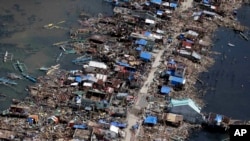MANILA —
In the typhoon-ravaged central Philippines, emergency workers are trying to push their way through piles of debris to recover bodies and get aid to people who have been stranded without food and water. Officials expect the number of dead to be in the thousands.
Most of those deaths are in Tacloban, a coastal city of Leyte Province. That is where Super Typhoon Haiyan first bore down on the country, leaving a trail of devastation across dozens of islands.
Thousands of houses have been reduced to rubble, while crumpled cars lie smashed into each other and splintered trees and power lines clog muddy ground.
Haiyan created a five-meter high storm surge that pounded Tacloban and left bodies tossed about in its wake. The Philippine Red Cross said its people on the ground estimated more than 1,000 people have died there.
Related video
Red Cross Secretary-General Gwendolyn Pang said body bags have been ordered, but right now the priority was getting 45,000 food packs to the families most in need.
“People are impatient already because they want to feel, they want to see significant support already since today is already the third day since the typhoon,” said Pang.
The Civil Defense office said about 450,000 people were currently displaced. Video footage from local news programs showed some residents looting grocery and other stores.
Philippines President Benigno Aquino toured some hard-hit areas Sunday. In contrast to the looting scenes shown on television, the president’s social media account posted photographs of residents in Tacloban waiting in line for relief goods with a caption saying they were “orderly lined up…” Vice President Jejomar Binay also visited one island calling the typhoon a “national tragedy.”
The Red Cross's Pang said managing the crisis was an overwhelming challenge, even with some roads partially cleared. Aid workers trying to bring in food and water supplies are struggling to communicate with each other.
The storm-battered provinces are contending with fallen cell towers and multiple power outages. And some places like Leyte are completely in the dark.
A National Police chief superintendent, Vic Loot, flew from Manila to Cebu Province Saturday to check on his home in Daan Bantayan town in the north. He and some emergency responders spent five hours cutting through fallen trees and electric poles with chainsaws just to get inside the town.
Daan Bantayan is Leyte’s main connection to the national power grid.
“Yeah, that is a very crucial point. And we need the roads there for the technicians to come, for the repairmen… the area should be cleared,” he said.
Loot said this point of the grid should be prioritized so power can be restored within 30 days, otherwise it could take about three months.
He said his house and nearly every single home in the town of 75,000 were severely damaged.
A number of countries have pledged monetary and humanitarian support to the Philippines.
U.N. emergency relief coordinator Valerie Amos said a U.N. disaster and assessment team has been deployed to Tacloban.
The United States is assisting with relief efforts. In a Saturday statement, the Defense Department said the U.S. Pacific Command had been directed to assist in search and rescue operations, and aircraft support.
Also, a U.S. relief team has been deployed to the region. The U.S. Agency for International Development (USAID) says the team will conduct damage assessments, track conditions and "advise on additional needs."
Weather agencies said Typhoon Haiyan was expected to hit northern Vietnam early Monday after moving northwest through the Gulf of Tonkin. The storm also dumped heavy rain on southern China's Hainan island to the east, forcing authorities to cancel flights.
Vietnamese authorities have evacuated several hundred thousand people from coastal areas where the storm's outer bands are causing high winds and rough seas.
Courtesy Taiwan Central Weather Bureau
Most of those deaths are in Tacloban, a coastal city of Leyte Province. That is where Super Typhoon Haiyan first bore down on the country, leaving a trail of devastation across dozens of islands.
Thousands of houses have been reduced to rubble, while crumpled cars lie smashed into each other and splintered trees and power lines clog muddy ground.
Haiyan created a five-meter high storm surge that pounded Tacloban and left bodies tossed about in its wake. The Philippine Red Cross said its people on the ground estimated more than 1,000 people have died there.
Related video
Red Cross Secretary-General Gwendolyn Pang said body bags have been ordered, but right now the priority was getting 45,000 food packs to the families most in need.
“People are impatient already because they want to feel, they want to see significant support already since today is already the third day since the typhoon,” said Pang.
The Civil Defense office said about 450,000 people were currently displaced. Video footage from local news programs showed some residents looting grocery and other stores.
Philippines President Benigno Aquino toured some hard-hit areas Sunday. In contrast to the looting scenes shown on television, the president’s social media account posted photographs of residents in Tacloban waiting in line for relief goods with a caption saying they were “orderly lined up…” Vice President Jejomar Binay also visited one island calling the typhoon a “national tragedy.”
The Red Cross's Pang said managing the crisis was an overwhelming challenge, even with some roads partially cleared. Aid workers trying to bring in food and water supplies are struggling to communicate with each other.
The storm-battered provinces are contending with fallen cell towers and multiple power outages. And some places like Leyte are completely in the dark.
A National Police chief superintendent, Vic Loot, flew from Manila to Cebu Province Saturday to check on his home in Daan Bantayan town in the north. He and some emergency responders spent five hours cutting through fallen trees and electric poles with chainsaws just to get inside the town.
Daan Bantayan is Leyte’s main connection to the national power grid.
“Yeah, that is a very crucial point. And we need the roads there for the technicians to come, for the repairmen… the area should be cleared,” he said.
Loot said this point of the grid should be prioritized so power can be restored within 30 days, otherwise it could take about three months.
He said his house and nearly every single home in the town of 75,000 were severely damaged.
A number of countries have pledged monetary and humanitarian support to the Philippines.
U.N. emergency relief coordinator Valerie Amos said a U.N. disaster and assessment team has been deployed to Tacloban.
The United States is assisting with relief efforts. In a Saturday statement, the Defense Department said the U.S. Pacific Command had been directed to assist in search and rescue operations, and aircraft support.
Also, a U.S. relief team has been deployed to the region. The U.S. Agency for International Development (USAID) says the team will conduct damage assessments, track conditions and "advise on additional needs."
Weather agencies said Typhoon Haiyan was expected to hit northern Vietnam early Monday after moving northwest through the Gulf of Tonkin. The storm also dumped heavy rain on southern China's Hainan island to the east, forcing authorities to cancel flights.
Vietnamese authorities have evacuated several hundred thousand people from coastal areas where the storm's outer bands are causing high winds and rough seas.
Courtesy Taiwan Central Weather Bureau












